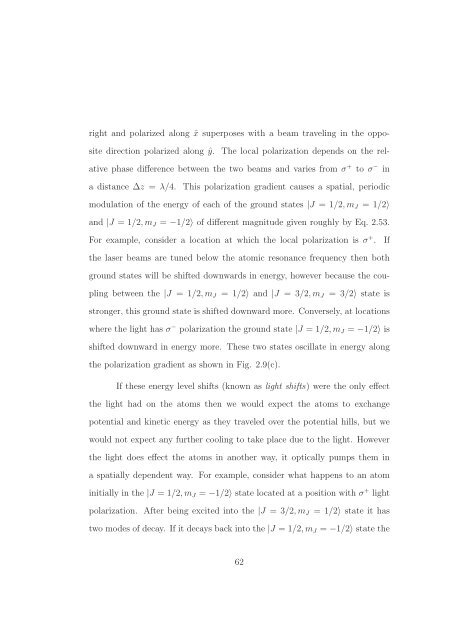Single-Photon Atomic Cooling - Raizen Lab - The University of ...
Single-Photon Atomic Cooling - Raizen Lab - The University of ...
Single-Photon Atomic Cooling - Raizen Lab - The University of ...
You also want an ePaper? Increase the reach of your titles
YUMPU automatically turns print PDFs into web optimized ePapers that Google loves.
ight and polarized along ˆx superposes with a beam traveling in the oppo-<br />
site direction polarized along ˆy. <strong>The</strong> local polarization depends on the rel-<br />
ative phase difference between the two beams and varies from σ + to σ − in<br />
a distance ∆z = λ/4. This polarization gradient causes a spatial, periodic<br />
modulation <strong>of</strong> the energy <strong>of</strong> each <strong>of</strong> the ground states |J = 1/2,mJ = 1/2〉<br />
and |J = 1/2,mJ = −1/2〉 <strong>of</strong> different magnitude given roughly by Eq. 2.53.<br />
For example, consider a location at which the local polarization is σ + . If<br />
the laser beams are tuned below the atomic resonance frequency then both<br />
ground states will be shifted downwards in energy, however because the cou-<br />
pling between the |J = 1/2,mJ = 1/2〉 and |J = 3/2,mJ = 3/2〉 state is<br />
stronger, this ground state is shifted downward more. Conversely, at locations<br />
where the light has σ − polarization the ground state |J = 1/2,mJ = −1/2〉 is<br />
shifted downward in energy more. <strong>The</strong>se two states oscillate in energy along<br />
the polarization gradient as shown in Fig. 2.9(c).<br />
If these energy level shifts (known as light shifts) were the only effect<br />
the light had on the atoms then we would expect the atoms to exchange<br />
potential and kinetic energy as they traveled over the potential hills, but we<br />
would not expect any further cooling to take place due to the light. However<br />
the light does effect the atoms in another way, it optically pumps them in<br />
a spatially dependent way. For example, consider what happens to an atom<br />
initially in the |J = 1/2,mJ = −1/2〉 state located at a position with σ + light<br />
polarization. After being excited into the |J = 3/2,mJ = 1/2〉 state it has<br />
two modes <strong>of</strong> decay. If it decays back into the |J = 1/2,mJ = −1/2〉 state the<br />
62
















